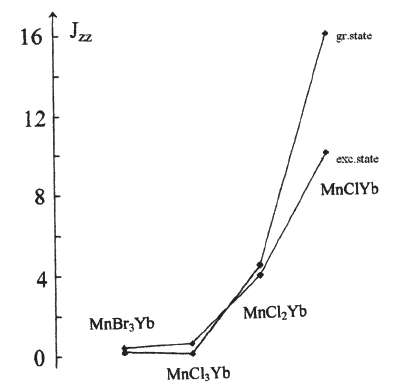Abstract of Publication No. 530
 M. Atanasov, C. Daul and H. U. Güdel
M. Atanasov, C. Daul and H. U. Güdel
Modelling of Anisotropic Exchange Coupling in Rare-Earth–Transition-Metal Pairs:
Applications to Yb3+-Mn2+ and Yb3+-Cr3+
Halide Clusters and Implications to the Light Up-Conversion
in "Computational Chemistry: Reviews of Current Trends", Volume 9
Ed. Jerzy Leszczynski
World Scientific Publishing, Singapore, ISBN 981-256-097-1, 153-194 (2005)
![]()
![]()
Abstract:
A procedure for calculating magnetic exchange coupling constants in rare
earth (RE)-transition metal (TM) dimers is presented. In a first step RE-TM
transfer (hopping) integrals between orbitals carrying unpaired (magnetic)
electrons on RE and TM are determined from a MO-calculation utilising the
concept of orbital exchange pathway and effective Hamiltonian theory. In a
second step, many-electron wave-functions for ground or excited electronic
states on RE and TM are constructed in which spin-orbit coupling (which
dominates for the RE) is fully (variationally) taken into account. Finally, the
data from steps 1 and 2 are combined to obtain numerical values for kinetic
exchange integrals (within Anderson's superexchange theory) utilising a
non-Heisenberg (orbital dependent) exchange operator. The MO's corresponding
to the d(Mn) and f(Yb) magnetic orbitals have been used to also calculate
ferromagnetic contributions to the exchange coupling. The model is applied to
Yb3+-Mn2+ dimers with corner, edge and face shared
octahedra and Cl– and Br–
ligands. For that purpose we utilise a spectroscopically adjusted (to spectra of
single nucleous octrahedral Mn2+, Cr3+ and
Yb3+ complexes) parameterisation
of the Extended Hückel theory. The expediency of the approach is discussed
based on a comparison between calculated and experimental (available from
inelastic neutron scattering experiments) anisotropic exchange parameters in
Br3Cr3+-m(Br3)-Yb3+Br3
dimers. Ferromagnetic exchange parameters for the
ground state and the lowest emitting excited state increase from corner to
edge to face Mn-Cl-Yb sharing thus varying in the same way as the efficiency
of the up-conversion found for such species. This lends support for an
exchange mechanism for this phenomenon postulated previously.